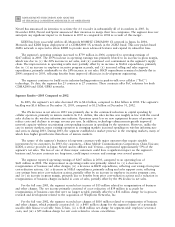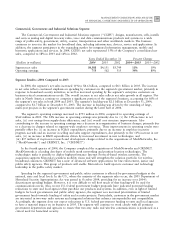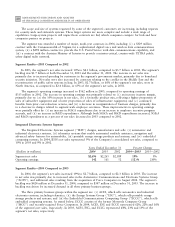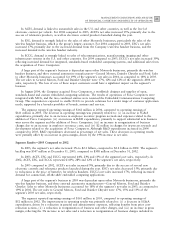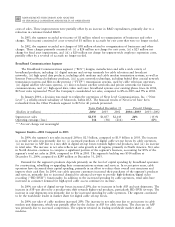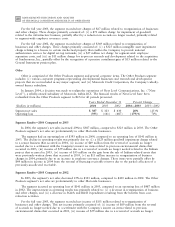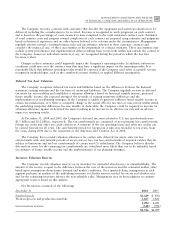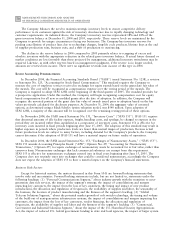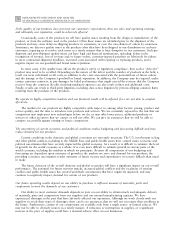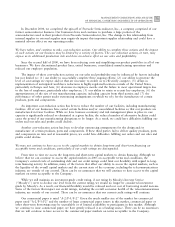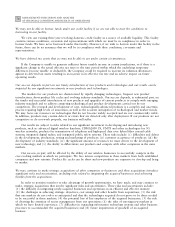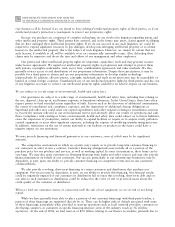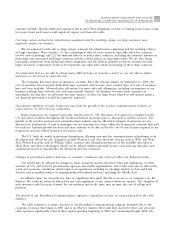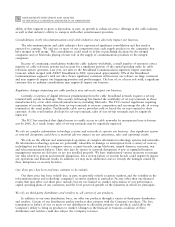Motorola 2004 Annual Report Download - page 76
Download and view the complete annual report
Please find page 76 of the 2004 Motorola annual report below. You can navigate through the pages in the report by either clicking on the pages listed below, or by using the keyword search tool below to find specific information within the annual report.
68 MANAGEMENT'S DISCUSSION AND ANALYSIS
OF FINANCIAL CONDITION AND RESULTS OF OPERATIONS
Plan was 8.50% in both 2004 and 2003. The investment return assumption for the OÇcers' Pension Plan was 6.00%
in both 2004 and 2003.
A second key assumption is the discount rate. The discount rate assumptions used for pension beneÑts and
postretirement health care beneÑts accounting reÖects, at December 31 of each year, the prevailing market rates for
high-quality, Ñxed-income debt instruments that, if the obligation was settled at the measurement date, would
provide the necessary future cash Öows to pay the beneÑt obligation when due. The Company's discount rate for
measuring the obligations was 6.00% at December 31, 2004, compared to 6.50% at December 31, 2003.
A Ñnal set of assumptions involves the cost drivers of the underlying beneÑts. The rate of compensation
increase is a key assumption used in the actuarial model for pension accounting and is determined by the Company
based upon its long-term plans for such increases. In both 2004 and 2003, the Company's rate for future
compensation increase was 4.00% for non-oÇcer employees and 3.00% for oÇcers. For retiree medical plan
accounting, the Company reviews external data and its own historical trends for health care costs to determine the
health care cost trend rates. Based on this review, the health care cost trend rate used to determine the
December 31, 2004 accumulated postretirement beneÑt obligation was 10% for 2005 with a declining trend rate of
1% each year until it reaches 5% by 2010, with a Öat 5% rate for 2010 and beyond.
At December 31, 2004, the Regular Pension Plan investment portfolio was predominantly equity investments
and the OÇcers' Pension Plan investment portfolio was predominantly Ñxed-income securities.
Negative Ñnancial market returns during 2000-2002 resulted in a decline in the fair-market value of plan assets.
This, when combined with declining discount rate assumptions in the last several years, has resulted in a decline in
the funded status of the Company's domestic and certain non-U.S. plans. Consequently, the Company's accumulated
beneÑt obligation for various plans exceeded the fair-market value of the plan assets for these plans at
December 31, 2004. The Company recorded a non-cash, after-tax, net charge of $188 million to equity relating to
the Regular Pension Plan, the OÇcers' Pension Plan, and certain non-U.S. subsidiaries retirement programs in the
fourth quarter of 2004. This charge was included in Non-Owner Changes to Equity in the consolidated balance
sheets, and did not impact the Company's pension expense, earnings or cash contribution requirements in 2004.
For the Regular Pension Plan, the Company currently estimates 2005 expenses for continuing operations will
be approximately $173 million. The 2004 and 2003 actual expenses, which include discontinued operations, were
$167 million and $137 million, respectively. Cash contributions of $580 million were made to the Regular Pension
Plan in 2004. The Company expects to make cash contributions of $150 million to this plan during 2005. In
addition, the Company expects to make cash contributions of $45 million to its Non U.S. pension plans in 2005.
For the Postretirement Health Care BeneÑts Plan, the Company currently estimates 2005 expenses for
continuing operations will be approximately $35 million. The 2004 and 2003 actual expenses, which include
discontinued operations, were $39 million and $43 million, respectively. The Company has partially funded its
accumulated beneÑt obligation of $544 million with Plan assets valued at $188 million at December 31, 2004.
Excluded from these accumulated beneÑt obligations was $217 million, representing post-retirement health care
beneÑt obligations transferred to Freescale Semiconductor, Inc. (""Freescale Semiconductor'') following the spin-oÅ
on December 2, 2004. In addition, Motorola is obligated to transfer to Freescale Semiconductor $68 million in cash
or plan assets, as permitted by law without adverse tax consequences to Motorola, with such transfer expected to
occur in 2005. No cash contributions were required in 2004, 2003 or 2002. The Company expects to make a cash
contribution of approximately $50 million to the retiree health care plan in 2005.
The impact on the future Ñnancial results of the Company in relation to retirement-related beneÑts is
dependent on economic conditions, employee demographics, interest rates and investment performance. The
Company's measurement date of its plan assets and obligations is December 31. Thus, during the fourth quarter of
each year, management reviews and, if necessary, adjusts the assumptions associated with its beneÑt plans.
Long-Term Contract Accounting
The Company applied the percentage-of-completion methodology as stated in Statement of Position 81-1,
""Accounting for Performance of Construction-Type and Certain Production-Type Contracts,'' to recognize revenues
on various long-term contracts involving proven technologies representing approximately 9% of the Company's net
sales in 2004. These contracts primarily involve the design, engineering, manufacturing, and installation of wireless
infrastructure communication systems by GTSS and two-way radio voice and data systems by CGISS. These systems
are designed to meet speciÑc customer speciÑcations and typically require an extended period of time to construct.


